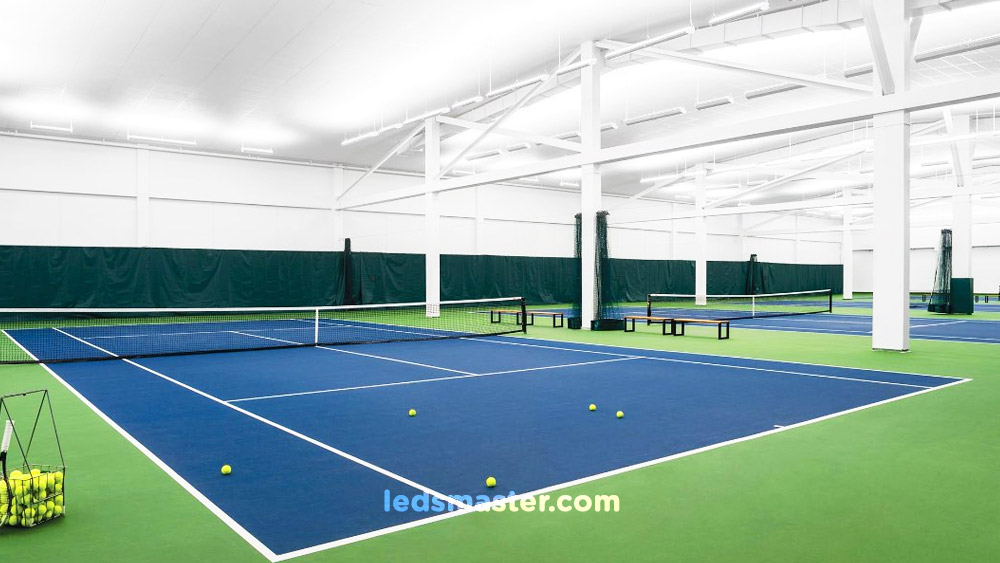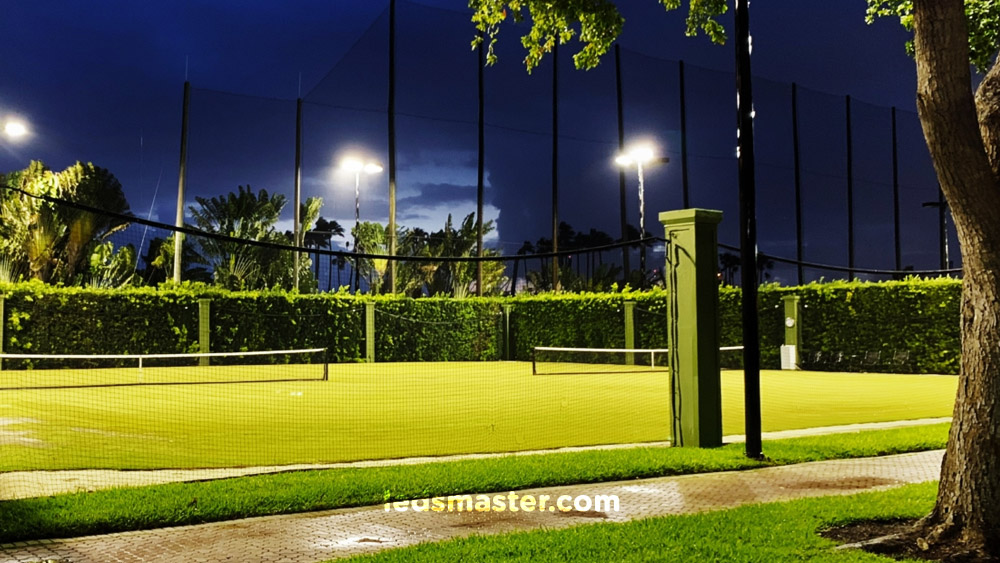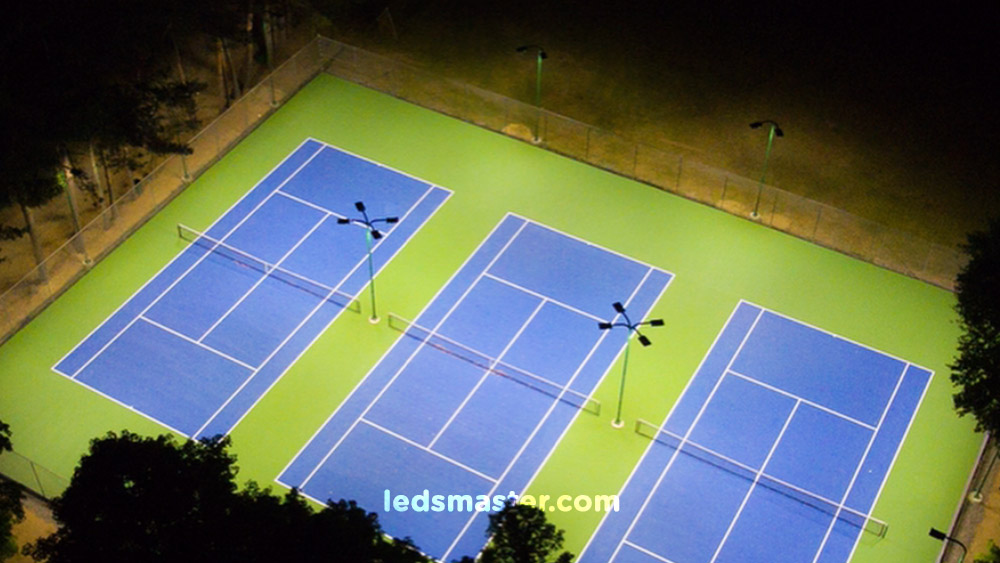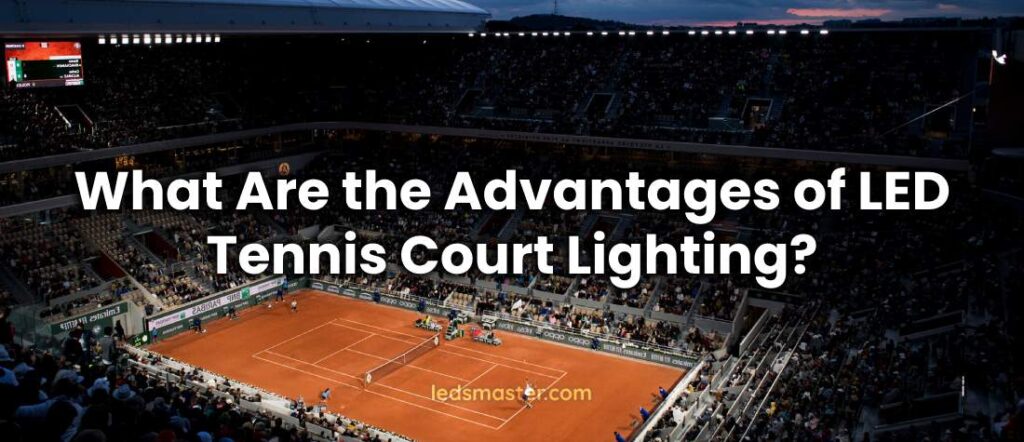LED, metal halide, and halogen lamps are commonly used for tennis court lighting. Choosing the right light source can significantly impact operational costs, maintenance, and the overall experience for tennis players. In this article, we will explain why LED lighting is superior for tennis courts and discuss its advantages over traditional metal halide and halogen lamps.
LED lighting has emerged as the preferred choice due to several key advantages. LEDs are highly energy-efficient, consuming less electricity compared to metal halide and halogen lamps, which leads to lower running costs over time. They also have a longer lifespan and require less frequent replacement, reducing maintenance expenses and ensuring reliable illumination for extended periods. Additionally, LEDs offer superior light quality with excellent color rendering and uniform distribution, enhancing visibility on the court by minimizing shadows and glare. These factors collectively contribute to a better playing experience for athletes and improved viewing conditions for spectators.
Table of Contents
ToggleWhat Are the Advantages of LED Lights for Tennis Court?
LED Tennis Court Lights Have Lower Operating Costs
LED lights offer numerous advantages for tennis courts. One of the most significant benefits is their lower operating costs compared to traditional lighting options. LED technology has become increasingly popular for both indoor and outdoor tennis courts due to its ability to provide bright, high-quality illumination that enhances player safety and visibility of the tennis net and fast-moving balls.
Switching from metal halide and halogen lamps to LED tennis court lights immediately demonstrates energy-saving benefits. For instance, replacing a 1000W metal halide lamp with a 250W LED equivalent can reduce energy consumption by up to 75%, leading to substantial savings on electricity bills. Moreover, fewer LED fixtures are often needed to achieve the same lighting levels as traditional lamps. Where a tennis court might require 20 metal halide lamps, only 4 to 6 LED lamps of equivalent wattage may be necessary. This retrofitting approach has become increasingly popular for tennis court managers seeking to optimize operational efficiency and reduce overall lighting costs.
The economic advantages extend beyond immediate savings, making LED conversion a smart investment for both commercial and residential tennis courts. Over time, the cumulative savings in energy costs contribute significantly to operational budgets, while also reducing the facility’s carbon footprint. As awareness grows about the environmental and financial benefits of LED lighting, more tennis court managers are choosing to upgrade their lighting systems to LEDs, ensuring both sustainable practices and improved financial management in the long run.
LED Tennis Court Lights Reduce Maintenance Costs

You’re absolutely right about the cost savings associated with LED lights, which can last approximately 30 years without needing replacement. For instance, LedsMaster’s LED tennis court lighting solutions are designed to operate for up to 150,000 hours, providing exceptional longevity and reliability.
In comparison, traditional lighting solutions such as metal halide and halogen lamps typically have much shorter lifespans, ranging from 10,000 to 20,000 hours. This stark contrast underscores the significant advantage of switching to LEDs in terms of reducing maintenance and replacement costs over the long term. With LEDs, tennis court operators can avoid the frequent expenses and inconveniences associated with replacing and reinstalling lights, thereby optimizing operational efficiency and budget management.
Opting for LED lights not only ensures prolonged performance and cost savings but also promotes sustainability. By minimizing the need for frequent replacements, LEDs contribute to reducing waste and environmental impact associated with discarded lamps. This makes LED tennis court lighting a prudent investment not only in terms of financial savings but also in supporting eco-friendly practices for a greener future.
Anti-glare Tennis Court LED Lights
Intense glare from traditional lighting sources can strain the eyes of tennis players and spectators alike, impacting their enjoyment and performance. LedsMaster’s tennis court lighting stands out with its patented optical design, which effectively reduces glare by up to 95%. This feature significantly enhances the playing experience, allowing tennis enthusiasts to enjoy matches comfortably even during nighttime sessions. In contrast, most metal halide and halogen lights lack this glare-reducing capability, often causing eye fatigue and discomfort after just 30 minutes of play.
The harsh glare emitted by conventional lighting not only affects visual comfort but also impairs tennis players’ performance, potentially hindering their ability to serve and play effectively. By switching to LED lights, the glare can be substantially minimized, creating a more pleasant and conducive environment for players. This improvement not only enhances visibility on the court but also contributes to better concentration and gameplay consistency, ensuring that competitive and recreational matches can be enjoyed with optimal clarity and comfort.
Improved Color Rendering with LED Lights on Tennis Courts

Tennis stands as a globally beloved sport, featuring prestigious events such as Wimbledon, the ATP Tour, and the Australian Open among many others. These tournaments, widely televised around the world, necessitate professional-grade lighting solutions. LED tennis court lights excel in meeting these stringent requirements due to their high Color Rendering Index (CRI) of 95+. This exceptional CRI ensures that tennis players perceive the true colors of the court surface with accuracy, while cameras capture every detail in true-to-life color.
The advanced high CRI lighting not only enhances the visibility and contrast on the court but also plays a crucial role in optimizing broadcast quality for 4K resolution. LedsMaster’s tennis court lighting solutions are specifically engineered for 4K broadcasting standards, reflecting our commitment to delivering superior visual fidelity. Our dedicated team of lighting engineers continually refines LED technology to maintain and improve its quality, ensuring that our lighting solutions not only meet but exceed the demanding standards of professional tennis tournaments. This focus on innovation and quality allows us to provide lighting systems that enhance the viewing experience for audiences worldwide, whether they are watching matches live or from the comfort of their homes.
Dimming Capability of LED Lights
Different types of tennis courts require varying lux levels tailored to their specific purposes. For professional competitions, tennis courts demand high-intensity lighting to ensure optimal visibility and performance for players. Conversely, recreational courts benefit from softer, dimmable lighting that enhances the ambiance without overpowering the environment. LED lights are particularly advantageous in these scenarios due to their versatility in adjusting brightness levels to meet the diverse lux requirements of different tennis court settings.
For tennis courts designed for regional competitions and recreational use, LED lighting offers an ideal solution. LED fixtures can be easily dimmed to accommodate varying lux levels, ranging from 200 lux suitable for leisurely play to 800 lux or higher for regional competitions. This flexibility allows tennis facility managers to adjust the lighting according to specific needs and activities, promoting both energy efficiency and tailored lighting solutions. Whether enhancing the competitive atmosphere of a regional tournament or creating a relaxed environment for recreational players, LED lights provide reliable performance and adaptability to ensure optimal conditions for tennis enthusiasts of all levels.
LED Tennis Lights Can Work in Extreme Temperatures
Metal halide or halogen lamps often struggle in extreme temperatures, where their performance can diminish significantly if it’s too hot or too cold. This variability in lighting intensity can impact the visibility and playability on tennis courts.
LED lights, on the other hand, offer a robust solution to this issue. Utilizing solid-state technology, LED tennis court lights can function effectively in temperatures ranging from -50°C to 50°C. This wide operational range ensures consistent and reliable performance, making LED lights particularly suitable for outdoor tennis courts where temperature fluctuations are common, such as in regions with distinct day-to-night temperature shifts. The stability of LED lights under varying environmental conditions makes them the preferred choice for maintaining optimal visibility and safety throughout different weather conditions, thereby enhancing the overall experience for tennis players and spectators alike.
Wide Range of Lighting Beam Angles

Tennis courts vary significantly in their layout, often featuring different configurations of light poles such as 4-pole, 6-pole, or 8-pole setups. Achieving uniform and effective illumination across these diverse layouts requires leveraging the wide range of beam angles available in tennis court lighting. By strategically selecting beam angles, we ensure that light is evenly distributed to every corner of the playing field, enhancing visibility and playability.
Our selection includes various beam angles tailored to meet the specific needs of both indoor and outdoor tennis courts. This diversity allows us to provide optimal lighting solutions regardless of the court’s size or layout. Additionally, we offer spotlights and floodlights designed specifically for tennis courts, each serving unique purposes in enhancing visibility and performance during matches.
Unlike traditional metal halide and halogen lights, which are constrained by limited beam angles due to their structural design, LED tennis court lighting offers a solution to this challenge. LEDs can be engineered with customizable beam angles that efficiently distribute light across the court, minimizing shadows and ensuring consistent brightness. This adaptability not only improves visibility but also enhances the overall playing experience, making LED lights the preferred choice for upgrading tennis court lighting systems.
Instantaneous Activation and Deactivation of Tennis Court Lighting
Switching to LED tennis court lighting allows for instant activation and deactivation, saving valuable time and operational costs.
Traditional metal halide lights often require a lengthy warm-up period of 10 to 15 minutes before reaching full brightness. This delay adds significant inconvenience, particularly for commercial tennis clubs or courts hosting national tournaments, where prompt lighting adjustments are crucial.
In contrast, LED lights for tennis courts can be instantly turned on and off in less than a second, offering immediate illumination and flexibility without the wait associated with conventional lighting technologies. This rapid response capability ensures efficient management of court lighting, enhancing the overall experience for players and optimizing operational efficiency for facility managers.
Minimizing Heat and UV Emissions in Tennis Courts
Did you know that incandescent lamps waste more than 90% of their energy as heat? For instance, a 1000W incandescent lamp converts approximately 900W of energy into heat, making it inefficient for lighting tennis courts. This excessive heat generation can lead to discomfort for players and spectators, particularly in warmer climates or during summer months when temperatures are already high.
LED lights offer significant advantages for tennis courts due to their efficient energy utilization. LEDs can convert up to 95% of their energy into visible light, minimizing heat production even at similar power consumption levels as incandescent or metal halide lamps. This efficiency not only enhances player comfort by reducing heat emissions but also contributes to lower energy costs and improved environmental sustainability.
Another benefit of LED tennis court lights is their ability to eliminate UV light emission, unlike halogen bulbs which emit UV radiation as part of their full-spectrum light output. LEDs achieve this by selectively emitting light within the visible spectrum, ensuring that no harmful UV rays are emitted. This feature makes LED lights safer and more suitable for both indoor and outdoor tennis courts, where minimizing UV exposure is important for player health and equipment longevity.
For more information on LED tennis court lighting or to schedule a complimentary lighting consultation, please don’t hesitate to reach out to us. We are committed to providing tailored lighting solutions that enhance performance, visibility, and energy efficiency for tennis facilities of all sizes and requirements.
Conclusion
LED lighting stands out as the optimal choice for illuminating tennis courts due to its numerous advantages over traditional options like metal halide and halogen lamps. LEDs offer unparalleled energy efficiency, significantly lower operating and maintenance costs, superior light quality with reduced glare, and enhanced color rendering. They provide flexibility in beam angles and lighting levels, ensuring optimal visibility and performance under varying conditions. Moreover, their instant activation and deactivation capabilities enhance operational efficiency. As tennis facilities increasingly prioritize sustainability and cost-effectiveness, the transition to LED lighting emerges as a prudent investment, promising long-term benefits for players, spectators, and facility managers alike.

